From Active Learning to Innovative Thinking: The Influence of Learning the Design Thinking Process among Students
Abstract
1. Introduction
2. Literature Review
2.1. Theoretical
2.2. The Designer
2.3. Education
2.4. Business
2.5. Metrics
3. Methodology
- I am creative;
- I am curious;
- I empathize with others;
- I like to think logically;
- I often involve other people in my plans;
- I like to cooperate with others;
- I make decisions with ease;
- I do not back down from a challenge;
- I like to try new solutions;
- I quickly adapt to changes;
- I believe that mistakes are a way of learning.
- Design thinking helps with focus.
- Design thinking brings added value to users.
- In design thinking, it is crucial to identify the user’s needs.
- Design thinking helps to find the best solution for every need.
- Design thinking always leads to one answer.
- In design thinking, one should always follow the leader.
- Design thinking is connected with disruptive innovations.
- The solutions we arrive at using design thinking are always very complex.
- For a design thinking solution, it is not important that it is applicable, only that it is well thought out.
- Design thinking contributes to organizational agility.
- Design thinking is only related to the process of creation, not to consumers.
4. Results
4.1. Survey Results
4.2. Experiment
5. Discussion
5.1. Theoretical/Conceptual Implications
5.2. Empirical Implications
5.3. Pedagogical Implications
6. Conclusions
Author Contributions
Funding
Institutional Review Board Statement
Informed Consent Statement
Data Availability Statement
Acknowledgments
Conflicts of Interest
References
- Bonwell, C.C.; Eison, J.A. Active learning: Creating excitement in the classroom. In Information Analyses—ERICClearinghouse Products (071); The George Washington University, School of Education and Human Development: Washington DC, USA, 1991; p. 3. ISBN 978-1-878380-08-1. ISSN 0884-0040. [Google Scholar]
- Handelsman, J.; Miller, S.; Pfund, C. Scientific Teaching; W.H. Freeman: New York, NY, USA, 2007. [Google Scholar]
- Letina, A. Strategije aktivnog učenja u nastavi prirode i društva. Školski Vjesn. Časopis Za Pedagog. Teor. I Praksu 2016, 65, 1–31. [Google Scholar]
- Tuta, J.; Luić, L.; Boras, D.; Radovac, D. Active Learning: Experiences and Educational Perspectives of the Application of Augmented Reality in Education and Training of Cadets. In Proceedings of the INTED2022 Conference, Online, 7–8 March 2022; pp. 7734–7741. [Google Scholar]
- Rittel, H.; Webber, M. Dilemmas in a General Theory of Planning. Policy Sci. 1973, 4, 155–169. [Google Scholar] [CrossRef]
- Brenner, W.; Uebernickel, F.; Abrell, T. Design Thinking for Innovation: Research and Practice; Springer International Publishing: St. Gallen, Switzerland, 2016. [Google Scholar]
- Matthews, J.H.; Wrigley, C. Design and Design thinking in business and management higher education. J. Learn. Des. 2017, 10, 41–54. [Google Scholar] [CrossRef]
- Avsec, S. Design thinking to enhance transformative learning. Glob. J. Eng. Educ. 2021, 23, 169–175. [Google Scholar]
- Arnold, J. Creative Engineering: Promoting Innovation by Thinking Differently. Edited with an Introduction and Biographical Essay by William J. Clancey. 2016. Available online: https://stacks.stanford.edu/file/druid:jb100vs5745/CreativeEngineering-JohnE.Arnold.pdf (accessed on 5 February 2023).
- Berglund, A.; Leifer, L. Beyond design thinking—Whose perspective is driving the people-Centric approach to change? In Proceedings of the International Conference on Engineering and Product Design Education (E&PDE17), Oslo, Norway, 7–8 September 2017. [Google Scholar]
- Weiland, K.; Knizhnik, J. Design thinking, lean startup, and high-technology marketing for human-centered systems engineering. Syst. Eng. 2022, 25, 207–223. [Google Scholar] [CrossRef]
- Seitz, T. Design Thinking and the New Spirit of Capitalism; Palgrave Pivot: Cham, Switzerland, 2020. [Google Scholar]
- Ge, X.; Leifer, L. Design thinking at the core: Learn new ways of thinking and doing by reframing. In Proceedings of the ASME Design Engineering Technical Conference, Cleveland, OH, USA, 6–9 August 2017. [Google Scholar] [CrossRef]
- Jordan, S.; Lande, M. Additive innovation in design thinking and making. Int. J. Eng. Educ. 2016, 32, 1438–1444. [Google Scholar]
- Ulibarri, N.; Cravens, A.E.; Cornelius, M.; Royalty, A.; Nabergoj, A.S. Research as design: Developing creative confidence in doctoral students through design thinking. Int. J. Dr. Stud. 2014, 9, 249–270. [Google Scholar] [CrossRef] [PubMed]
- Linton, G.; Klinton, M. University entrepreneurship education: A design thinking approach to learning. J. Innov. Entrep. 2019, 8, 3. [Google Scholar] [CrossRef]
- Schubert, K.D.; Massey, L.; Ellstrand, A. Expanding and evolving an innovation concentration. In Proceedings of the 2019 ASEE Annual Conference & Exposition, Tampa, FL, USA, 16–19 June 2019. [Google Scholar] [CrossRef]
- Levy, M. Educating for empathy in software engineering course. In Proceedings of the CEUR Workshop, Utrecht, The Netherlands, 19 March 2018; Volume 2075. [Google Scholar]
- Silla, C. Teaching Entrepreneurship for Computer Science and Engineering Students Using Active Learning Pedagogical Strategies. In Proceedings of the 2021 IEEE Frontiers in Education Conference (FIE), Lincoln, NE, USA, 13–16 October 2021. [Google Scholar] [CrossRef]
- Marks, J.; Chase, C. Impact of a prototyping intervention on middle school students’ iterative practices and reactions to failure. J. Eng. Educ. 2019, 108, 547–573. [Google Scholar] [CrossRef]
- Hashim, A.; Aris, S.; Fook, C. Promoting empathy using design thinking in project-based learning and as a classroom culture. Asian J. Univ. Educ. 2019, 15, 14–23. [Google Scholar] [CrossRef]
- Bourgeois-Bougrine, S.; Latorre, S.; Mourey, F. Promoting creative imagination of non-expressed needs: Exploring a combined approach to enhance design thinking|Neišreikštų kūrybinės vaizduotės poreikių skatinimas: Mišraus požiūrio į dizaineriškos mąstysenos stiprinimą tyrimas. Creat. Stud. 2018, 11, 377–394. [Google Scholar] [CrossRef]
- Tsai, M.-F. Exploration of students’ integrative skills developed in the design thinking of a Psychology course. Think. Ski. Creat. 2021, 41, 100893. [Google Scholar] [CrossRef]
- McLuskie, P.; Dewitt, S. Design thinking pedagogy and enterprise education. In Proceedings of the European Conference on Innovation and Entrepreneurship, ECIE, Kalamata, Greece, 19–20 September 2019; pp. 648–656. [Google Scholar]
- Gachago, D.; Van Zyl, I.; Hitge, L.; Ivala, E.; Morkel, J. Designing for design thinking: Fostering an elearning champion mindset through academic staff development. In Proceedings of the International Conference on e-Learning, ICEL, Cape Town, South Africa, 5–6 June 2018; pp. 104–112. [Google Scholar]
- Wilson, J.A.; Hiley, A.; Collis, A. The development of a module to equip students with real-world problem-solving skills. In Proceedings of the EE 2008—International Conference on Innovation, Good Practice and Research in Engineering Education, Loughborough, UK, 14–16 July 2008. [Google Scholar]
- Artiles, J.; Lande, M. Broadening non-designers’ solutions for big issues: The Education DesignShop design thinking workshop. Int. J. Eng. Educ. 2016, 32, 1418–1427. [Google Scholar]
- Traifeh, H.; Nicolai, C.; Refaie, R.; Meinel, C. Engaging digital engineering students in design thinking. In Proceedings of the Conference: NordDesign 2020, Lyngby, Denmark, 12–14 August 2020. [Google Scholar] [CrossRef]
- Bouwman, S.; Voorendt, J.; Eisenbart, B.; McKilligan, S. Design thinking: An approach with various perceptions. In Proceedings of the International Conference on Engineering Design, ICED, Delft, The Netherlands, 5–8 August 2019; pp. 1443–1452. [Google Scholar] [CrossRef]
- Radnejad, A.; Sarkar, S.; Osiyevskyy, O. Design thinking in responding to disruptive innovation: A case study. Int. J. Entrep. Innov. 2022, 23, 39–54. [Google Scholar] [CrossRef]
- Dobrigkeit, F.; De Paula, D. Design thinking in practice: Understanding manifestations of design thinking in software engineering. In Proceedings of the 2019 27th ACM Joint Meeting, Munich, Germany, 15–20 September 2019; pp. 1059–1069. [Google Scholar] [CrossRef]
- Lehtonen, M.; Yeow, P.; Chew, J. Empowering change for future-making: Developing agency by framing wicked problems through design. Futures 2022, 139, 102952. [Google Scholar] [CrossRef]
- Malik, N.; Khalil, G.; Al Amoodi, A.; Bakhsh, M.S.M. Combatting Resistance to Change during the COVID 19 Pandemic with Design Thinking Approach: Making a Case for the Public Sector. In Proceedings of the 2021 International Conference on Innovation and Intelligence for Informatics, Computing, and Technologies, 3ICT, Virtual, 29–30 September 2021; pp. 658–663. [Google Scholar] [CrossRef]
- Brown, T. Design Thinking. Harv. Bus. Rev. 2008, 86, 84–92. [Google Scholar] [PubMed]
- McLaughlin, J.E.; Chen, E.; Lake, D.; Guo, W.; Skywark, E.R.; Chernik, A.; Liu, T. Design thinking teaching and learning in higher education: Experiences across four universities. PLoS ONE 2022, 17, e0265902. [Google Scholar] [CrossRef] [PubMed]
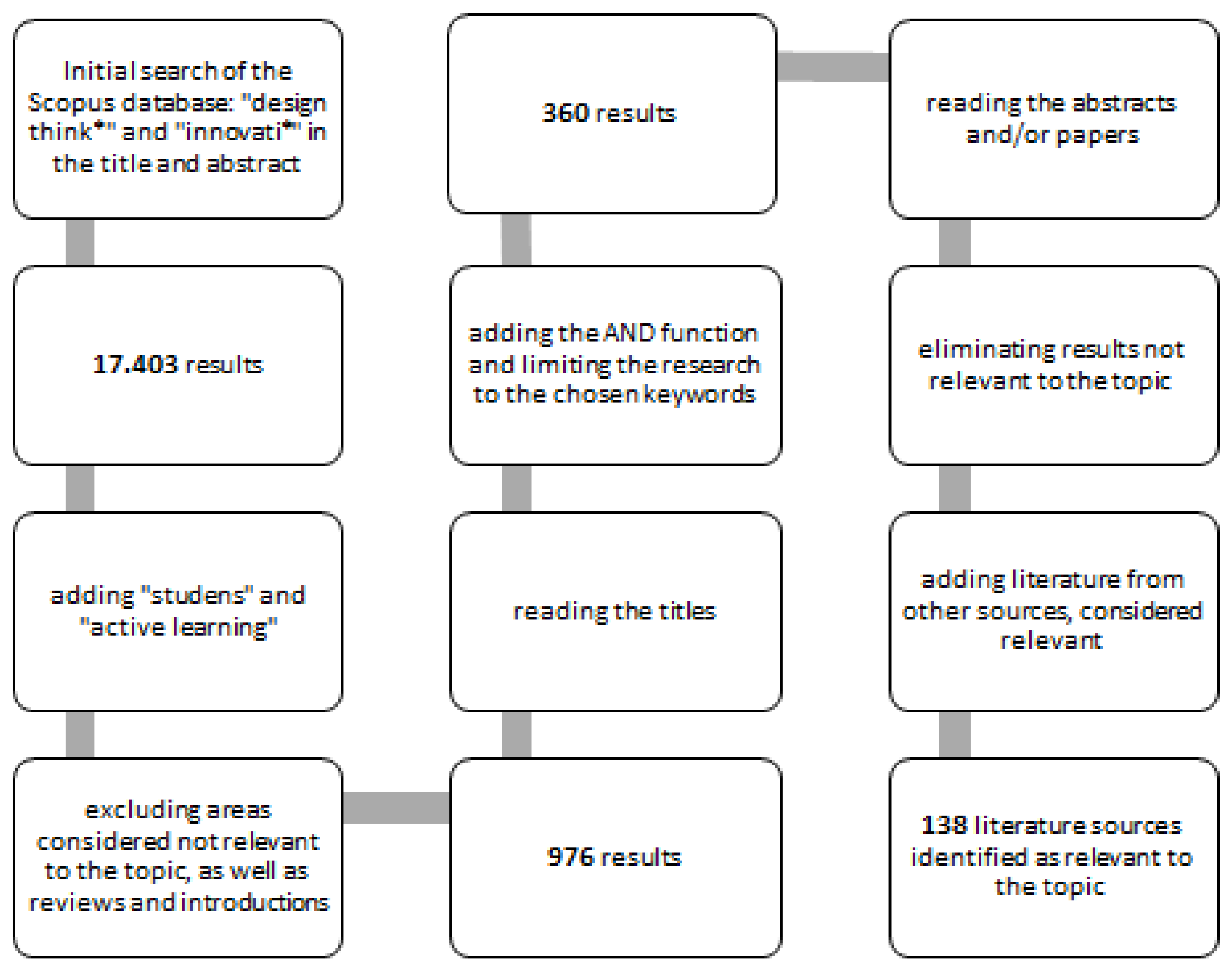
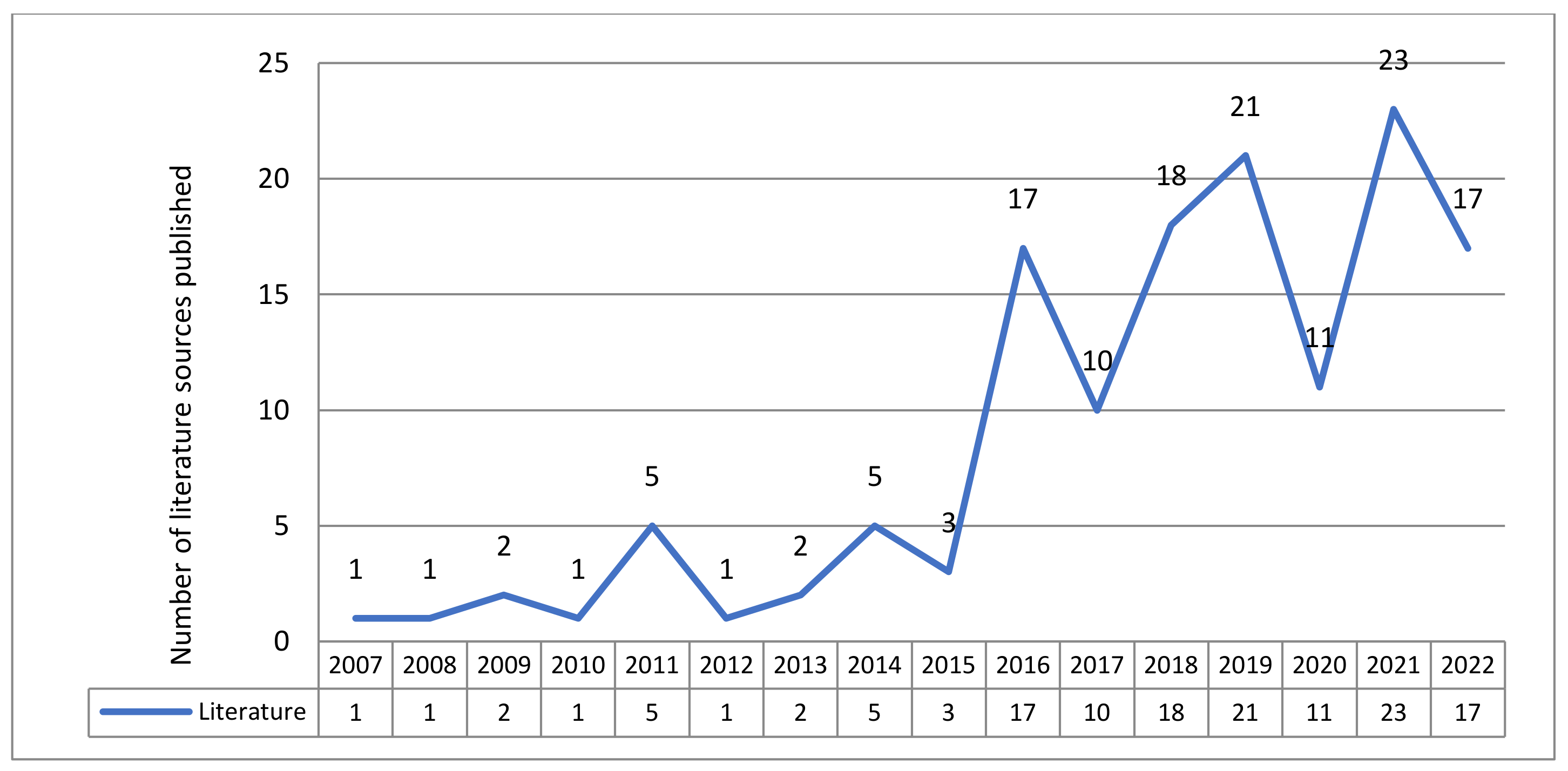

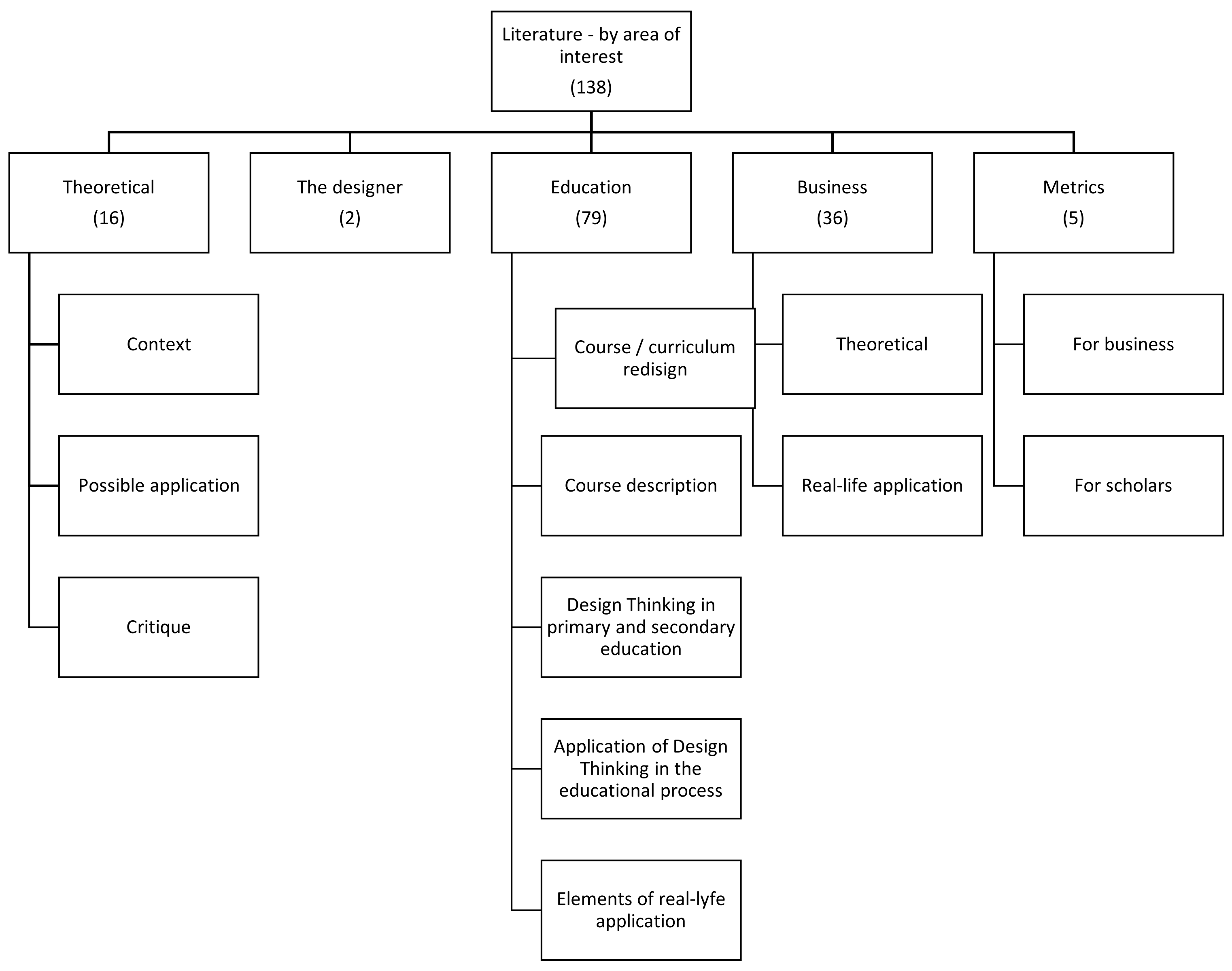
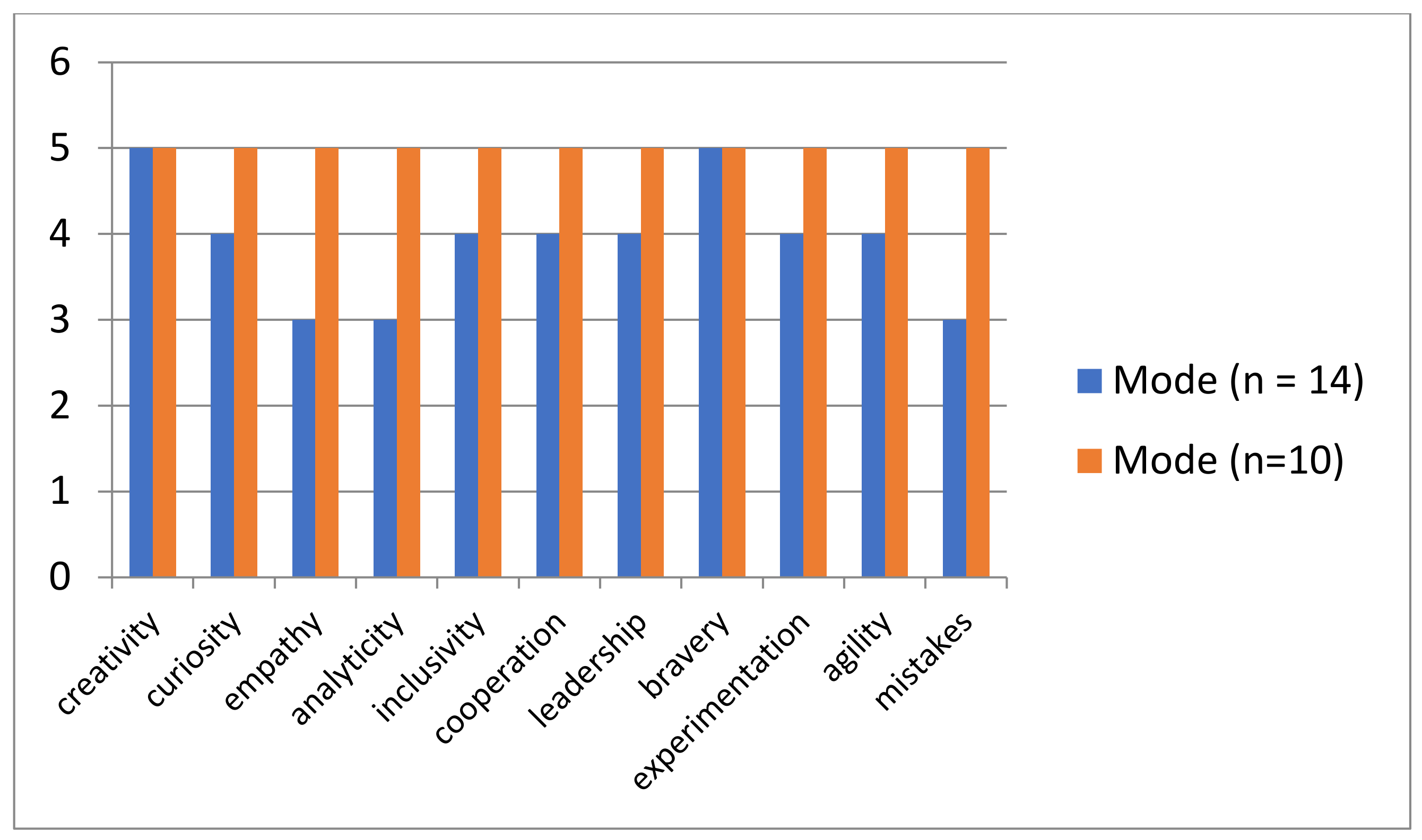
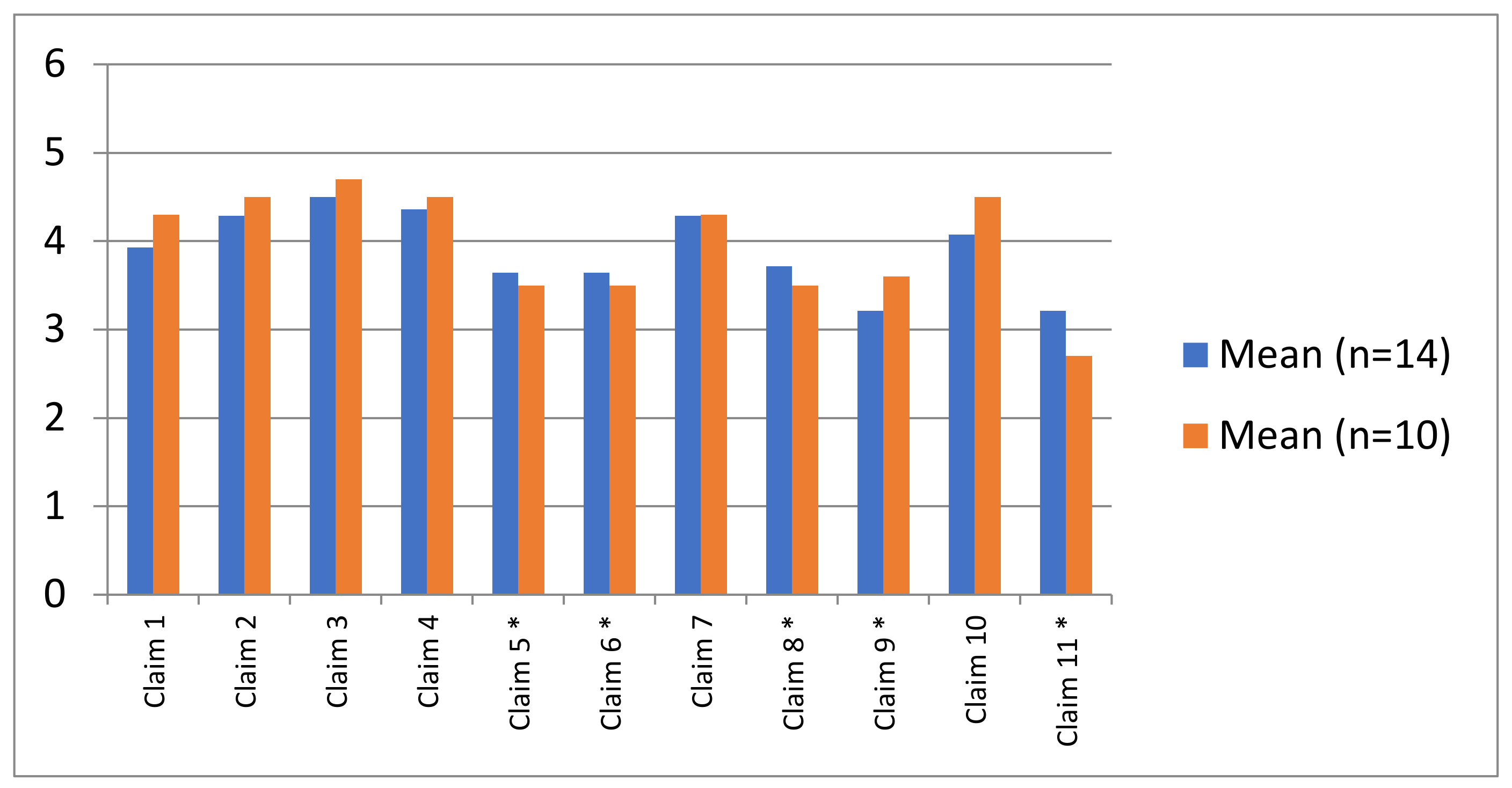

| Items (Variables) | Cronbach Alpha Coefficient | |
|---|---|---|
| First survey (n = 14) | 44 | 0.8664 |
| Second survey (n = 10) | 44 | 0.9036 |
| Variable | n | Min | Max | Mean | Median | Mode | Standard Deviation | Variance |
|---|---|---|---|---|---|---|---|---|
| creativity | 10 | 4 | 5 | 4.60 | 5 | 5 | 0.516 | 0.267 |
| curiosity | 10 | 3 | 5 | 4.50 | 5 | 5 | 0.707 | 0.500 |
| empathy | 10 | 4 | 5 | 4.70 | 5 | 5 | 0.483 | 0.233 |
| analyticity | 10 | 3 | 5 | 4.40 | 5 | 5 | 0.843 | 0.711 |
| inclusivity | 10 | 3 | 5 | 4.20 | 4 | 5 | 0.789 | 0.622 |
| cooperation | 10 | 3 | 5 | 4.40 | 5 | 5 | 0.843 | 0.711 |
| leadership | 10 | 3 | 5 | 4.40 | 4.5 | 5 | 0.699 | 0.489 |
| bravery | 10 | 4 | 5 | 4.70 | 5 | 5 | 0.483 | 0.233 |
| experimentation | 10 | 4 | 5 | 4.70 | 5 | 5 | 0.483 | 0.233 |
| agility | 10 | 4 | 5 | 4.50 | 4.5 | 5 | 0.527 | 0.278 |
| mistakes | 10 | 4 | 5 | 4.50 | 4.5 | 5 | 0.527 | 0.278 |
| Claims | |
|---|---|
| 1 | Design thinking helps with focus. |
| 2 | Design thinking brings added value to users. |
| 3 | In design thinking, it is crucial to identify the user’s need. |
| 4 | Design thinking helps to find the best solution for every need. |
| 5 | * Design thinking always leads to one answer. |
| 6 | * In design thinking one should always follow the leader. |
| 7 | Design thinking is connected with disruptive innovations. |
| 8 | * The solutions we arrive at using design thinking are always very complex. |
| 9 | * For a design thinking solution, it is not important that it is applicable, only that it is well thought out. |
| 10 | Design thinking contributes to organizational agility. |
| 11 | * Design thinking is only related to the process of creation, not to consumers. |
| Variable | n | Min | Max | Mean | Median | Mode | Standard Deviation | Variance |
|---|---|---|---|---|---|---|---|---|
| Claim 1 | 10 | 3 | 5 | 4.30 | 4 | 4 | 0.675 | 0.456 |
| Claim 2 | 10 | 3 | 5 | 4.50 | 5 | 5 | 0.707 | 0.500 |
| Claim 3 | 10 | 3 | 5 | 4.70 | 5 | 5 | 0.675 | 0.456 |
| Claim 4 | 10 | 3 | 5 | 4.50 | 5 | 5 | 0.707 | 0.500 |
| Claim 5 * | 10 | 1 | 5 | 3.50 | 4 | 4 | 1.434 | 2.056 |
| Claim 6 * | 10 | 1 | 5 | 3.50 | 4 | 4 | 1.269 | 1.611 |
| Claim 7 | 10 | 3 | 5 | 4.30 | 4 | 4 | 0.675 | 0.456 |
| Claim 8 * | 10 | 2 | 5 | 3.50 | 3.5 | 3 | 0.850 | 0.722 |
| Claim 9 * | 10 | 1 | 5 | 3.60 | 4 | 5 | 1.506 | 2.267 |
| Claim 10 | 10 | 3 | 5 | 4.50 | 5 | 5 | 0.707 | 0.500 |
| Claim 11 * | 10 | 1 | 5 | 2.70 | 2 | 2 | 1.636 | 2.678 |
| Variable | n | Min | Max | Mean | Median | Mode | Standard Deviation | Variance |
|---|---|---|---|---|---|---|---|---|
| insight | 10 | 4 | 5 | 4.70 | 5 | 5 | 0.483 | 0.233 |
| reducing preconceptions | 10 | 3 | 5 | 4.20 | 4 | 4 | 0.632 | 0.400 |
| a new way of perception | 10 | 4 | 5 | 4.90 | 5 | 5 | 0.316 | 0.100 |
| inclusiveness | 10 | 4 | 5 | 4.60 | 5 | 5 | 0.516 | 0.267 |
| not linear thinking | 10 | 4 | 5 | 4.40 | 4 | 4 | 0.516 | 0.267 |
| logical thinking | 10 | 3 | 5 | 4.20 | 4 | 4 | 0.632 | 0.400 |
| focus | 10 | 3 | 5 | 4.30 | 4.5 | 5 | 0.823 | 0.678 |
| teamwork | 10 | 2 | 5 | 4.30 | 5 | 5 | 1.059 | 1.122 |
| risk seeking | 10 | 2 | 5 | 4.10 | 4 | 4 | 0.994 | 0.989 |
| practical use | 10 | 3 | 5 | 4.50 | 5 | 5 | 0.707 | 0.500 |
| curiosity | 10 | 3 | 5 | 4.50 | 5 | 5 | 0.707 | 0.500 |
| Participants | Participant 1 | Participant 2 | Participant 3 | Participant 4 | Participant 5 | |
|---|---|---|---|---|---|---|
| Stakeholders | Part-time students | Part-time students | All academic course staff (+students) | Part-time students, course instructors | Full-time students, part-time students, all academic course staff | |
| Identified need | Occasional need for online classes/seminars, as well as practical exams | Remote class attendance | To create an innovation and “anticipate” expectations (of the academic course staff) | Limited duration of the course versus the scope of the course content | Passing the exam/evaluating the students | |
| Proposed solution | Theory classes: online Seminars: face to face Grading: based on solving a real-life business problem | Classes online or face to face with the possibility of joining remotely | Creative workshops | Podcasts An online library with digitized material available to students | An application that “examines” students | |
| Self-assessment | Is it innovative? | YES | NO | YES | YES | YES |
| Is it technically feasible? | YES | YES | YES | YES | YES | |
| Can it be replicated? | NO | YES | YES | YES | YES |
Disclaimer/Publisher’s Note: The statements, opinions and data contained in all publications are solely those of the individual author(s) and contributor(s) and not of MDPI and/or the editor(s). MDPI and/or the editor(s) disclaim responsibility for any injury to people or property resulting from any ideas, methods, instructions or products referred to in the content. |
© 2023 by the authors. Licensee MDPI, Basel, Switzerland. This article is an open access article distributed under the terms and conditions of the Creative Commons Attribution (CC BY) license (https://creativecommons.org/licenses/by/4.0/).
Share and Cite
Baričević, M.; Luić, L. From Active Learning to Innovative Thinking: The Influence of Learning the Design Thinking Process among Students. Educ. Sci. 2023, 13, 455. https://doi.org/10.3390/educsci13050455
Baričević M, Luić L. From Active Learning to Innovative Thinking: The Influence of Learning the Design Thinking Process among Students. Education Sciences. 2023; 13(5):455. https://doi.org/10.3390/educsci13050455
Chicago/Turabian StyleBaričević, Martina, and Ljerka Luić. 2023. "From Active Learning to Innovative Thinking: The Influence of Learning the Design Thinking Process among Students" Education Sciences 13, no. 5: 455. https://doi.org/10.3390/educsci13050455
APA StyleBaričević, M., & Luić, L. (2023). From Active Learning to Innovative Thinking: The Influence of Learning the Design Thinking Process among Students. Education Sciences, 13(5), 455. https://doi.org/10.3390/educsci13050455







